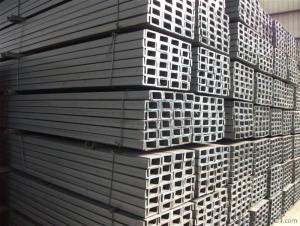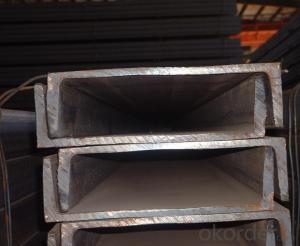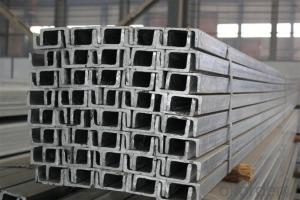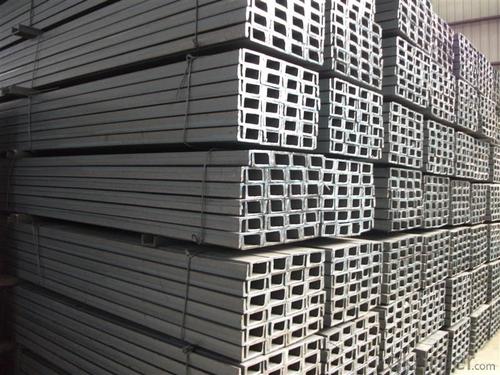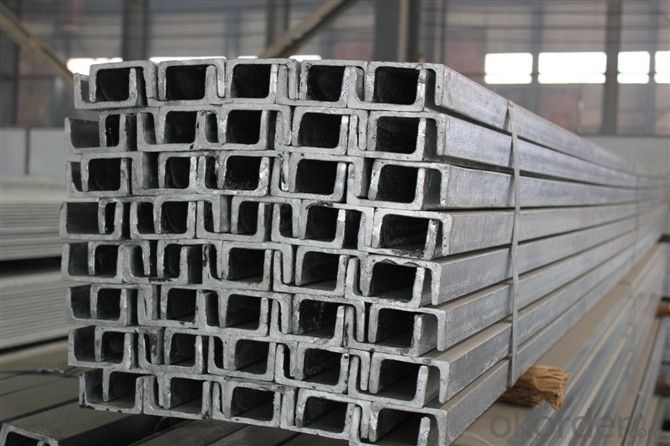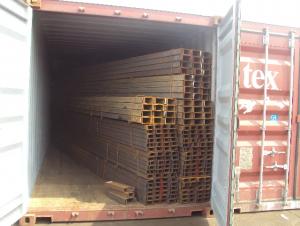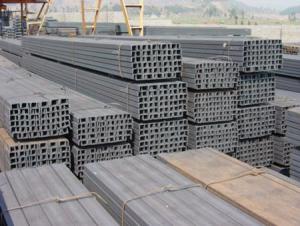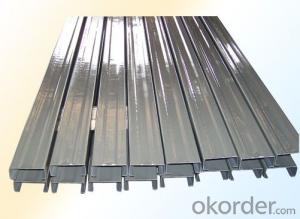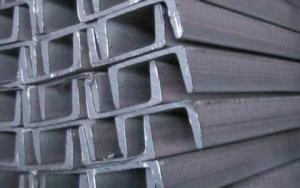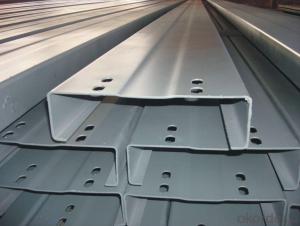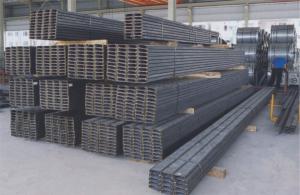Steel channel GB for sale
- Loading Port:
- Shanghai
- Payment Terms:
- TT OR LC
- Min Order Qty:
- 25 m.t.
- Supply Capability:
- 10000 m.t./month
OKorder Service Pledge
OKorder Financial Service
You Might Also Like
Steel U Channel Details:
Minimum Order Quantity: 25 Tons Unit: m.t. Loading Port: Xingang Port
Supply Ability: 1000 Tons Per Day Payment Terms: TT or L/C
Product Description:
Specifications of Steel U Channel:
Standard Applied: GB Standard, EN Standard(UPN), JIS Standard
Sizes: 50mm to 300mm
Material Grade: Q235B, Q345B, S235JR, SS400, ASTM A36
As shown in the figure:
Usage/Application of Steel U Channel:
The steel u channel can be applied to construction of warehouses, workshops, sport stadiums and car parks etc. In details, the steel u channel belongs to carbon structural steel which is applied to in the field of construction and machinery. The steel u channel is usually used for arch-itechtural structure, and they could be welded in order to support or hang a vari-ety of facilities. They are also usually used in combination with I beam. Generally,the steel u channel must possess perfect welding property, riveting property and mechanical property and so on.
Package & Delivery: Steel U Channel
The steel u channel will be packed in bundle with steel wire at each end of every bundle and color marking in order to help the customer to recognize his goods more easily at sight.
And steel u channel could be loaded into 20ft or 40ft container, or by bulk cargo. If the weight of each bundle reaches less than 3.5 mt, the loading by break bulk cargo should be choosed. When the weight of each bundle reaches less than 3mt, the loading by container should be choosed.
As for the transportaion from mill to loading port, the truck will be usually used. And the maximum quantity for each truck is 40mt.
All in all, we could do in accordance with customer's request
- Q: Are steel channels suitable for high-temperature applications?
- High-temperature applications can typically make use of steel channels. Steel possesses the advantageous qualities of strength and resistance to high temperatures, thereby maintaining its structural integrity. However, the appropriateness of steel channels for high-temperature applications relies on several factors, including the grade of steel employed, the temperature range involved, and the duration of exposure to elevated temperatures. Particular grades of steel, such as stainless steel, prove especially well-suited for high-temperature applications due to their exceptional resistance to corrosion and oxidation. Industries like automotive, aerospace, and chemical processing commonly employ stainless steel channels, as these sectors necessitate exposure to heightened temperatures. Determining the suitability of steel channels for high-temperature applications necessitates considering the specific temperature range. Steel commences losing its strength and structural integrity as temperatures rise. Consequently, it becomes crucial to select a steel grade capable of enduring the desired temperature range without compromising its performance. The duration of exposure to high temperatures also warrants consideration. Extended exposure to elevated temperatures can induce structural alterations in steel, including softening or distortion. To prevent significant deterioration, it is essential to employ steel channels designed to withstand the anticipated duration of exposure. In conclusion, steel channels generally prove suitable for high-temperature applications. Nonetheless, ensuring the desired performance and structural integrity necessitates selecting the appropriate steel grade, accounting for the specific temperature range, and evaluating the duration of exposure.
- Q: The top of the elevator shaft is not pre buried hook, and now to add channel, in the channel to do hook, elevator Ii Michihiro 2500, asking the hook bearing 3 tons, the need for large channel, detailed explanation
- What is the midpoint moment by channel loadGood 30# I-beam, made of fish bellied beam
- Q: What are the different types of connections used for steel channels in bridges?
- There are several types of connections used for steel channels in bridges, each with its own advantages and considerations. Some of the common types include: 1. Welded connections: Welding is a widely used method to connect steel channels in bridges. It involves heating the materials to their melting point and then joining them together. Welded connections are known for their strength and durability. However, they require skilled labor and proper quality control to ensure the integrity of the welds. 2. Bolted connections: Bolted connections involve using bolts and nuts to fasten steel channels together. This type of connection offers flexibility as it allows for disassembly and reassembly if needed. It is also relatively easier to install and inspect compared to welded connections. However, bolted connections may require periodic maintenance to ensure the tightness of the bolts. 3. Riveted connections: Rivets were commonly used in older bridge constructions. They involve inserting a rivet into a pre-drilled hole and then deforming it to hold the steel channels together. While riveted connections provide good shear resistance, they are less commonly used today due to the labor-intensive installation process and difficulties in inspection and maintenance. 4. High-strength bolted connections: High-strength bolts are similar to regular bolts but have higher tensile strength. These connections are commonly used in modern bridge constructions as they provide high resistance to shear and tension forces. High-strength bolted connections require specialized tools and careful installation to achieve the desired strength. 5. Moment connections: Moment connections are designed to transfer bending moments between steel channels in bridges. These connections are typically used in situations where the bridge experiences significant lateral forces, such as in earthquake-prone areas. Moment connections are usually welded and require careful design and analysis to ensure their performance under different loading conditions. It is important to note that the selection of connection types depends on various factors, including bridge design, anticipated loads, construction techniques, and maintenance requirements. Engineers and designers consider these factors to determine the most appropriate connections that will provide the necessary strength, durability, and safety for steel channels in bridges.
- Q: Are steel channels available in different colors?
- No, steel channels are typically only available in their natural silver color.
- Q: Can steel channels be used for creating support structures for plumbing systems?
- Yes, steel channels can be used for creating support structures for plumbing systems. Steel channels provide strength and durability, making them suitable for supporting the weight of plumbing pipes and fixtures. They can be easily fabricated and installed, offering stability and longevity to plumbing systems.
- Q: Can steel channels be used in the renewable energy manufacturing industry?
- Certainly, the renewable energy manufacturing industry can make use of steel channels. Steel channels are versatile structural components with a wide range of applications in different industries, including renewable energy. When manufacturing equipment such as wind turbines, solar panels, and hydroelectric systems, steel channels can serve various purposes. Support structures are one of the primary applications of steel channels in the renewable energy manufacturing industry. To withstand the forces exerted by wind, wind turbines require robust support structures. Steel channels offer the necessary strength and rigidity to carry the weight of the turbine and its rotating blades. Similarly, in the production of solar panels, steel channels are often employed to construct the framework that holds the photovoltaic cells in place. These channels provide a stable and durable structure that can endure various weather conditions, ensuring the long life of the solar panels. Moreover, steel channels can also be used in the manufacturing of hydroelectric systems. These systems involve constructing dams, penstocks, and other water control structures. Steel channels are commonly utilized to build frames and supports for these structures, guaranteeing their stability and durability. Apart from support structures, steel channels can also find utility in the renewable energy manufacturing industry for cable management and electrical wiring. They can be utilized to create cable trays or conduit systems that organize and safeguard electrical cables in wind turbines, solar farms, or other renewable energy installations. In conclusion, steel channels are indeed suitable for use in the renewable energy manufacturing industry. Their strength, versatility, and durability make them an excellent choice for support structures, framework construction, cable management, and various other applications.
- Q: What are the different methods for protecting steel channels from UV radiation?
- There are various ways to safeguard steel channels from UV radiation. 1. Painting: Applying a UV-resistant paint coating on the steel channels is a common method. These paints contain special additives that reflect or absorb UV radiation, preventing it from reaching the steel and causing deterioration. 2. Powder coating: Another effective technique is powder coating. This involves applying dry powder electrostatically to the steel's surface and then heating it to create a protective coating. Powder coatings come in different colors and finishes, many of which offer excellent UV resistance. 3. Galvanization: Galvanizing steel channels is a popular method for shielding them from UV radiation and corrosion. It involves coating the steel with a layer of zinc, which acts as a sacrificial barrier against UV rays and other environmental factors, significantly prolonging the channels' lifespan. 4. UV-resistant coatings: Specialized UV-resistant coatings designed for steel protection can be found in the market. These coatings are typically applied as a liquid and create a thin, transparent layer on the steel's surface. They provide outstanding UV protection while maintaining the channels' appearance. 5. Protective films: Protective films or tapes can also be used to shield steel channels from UV radiation. These films are directly applied to the steel's surface and act as a barrier against UV rays. They are easy to install and remove, making them a cost-effective temporary protection solution. Choosing the most suitable method depends on the specific application and requirements. Factors such as the level of UV exposure, desired lifespan, and aesthetic considerations should be taken into account when selecting a method to protect steel channels from UV radiation.
- Q: What are the common applications of steel channels?
- Steel channels, also referred to as C-channels or U-channels, have a wide range of uses in different industries. Below are some examples of how steel channels are commonly utilized: 1. In the construction sector, steel channels play a crucial role in providing structural support and framing. They offer strength and stability to buildings, bridges, and other structures. Steel channels are commonly used as beams, columns, and purlins to distribute weight and resist deformation. 2. Building facades benefit from the use of steel channels as decorative and functional elements. They can be employed as curtain wall frames, window frames, and supports for cladding. Steel channels provide durability, resistance to weather conditions, and a sleek appearance to the exterior of buildings. 3. Manufacturing and industrial applications make extensive use of steel channels for various equipment and machinery. They serve as support structures for conveyor systems, racks, shelves, and platforms. Steel channels have a high load-bearing capacity and can withstand heavy loads, making them suitable for industrial purposes. 4. In electrical installations, steel channels are commonly used to offer support and protection for electrical cables and wiring. They can be utilized as cable trays, raceways, and support systems for electrical equipment. Steel channels ensure organized and secure routing of electrical cables, preventing damage and reducing the risk of electrical hazards. 5. The automotive industry employs steel channels for different purposes. They are utilized in the construction of vehicle frames, chassis, and suspension systems. Steel channels provide strength, rigidity, and impact resistance, ensuring the structural integrity and safety of automobiles. 6. Infrastructure projects such as bridges, highways, and railways rely on steel channels as crucial components. They are used in the construction of bridge beams, guardrails, and noise barriers. Steel channels offer excellent load-bearing capabilities and durability, making them suitable for heavy-duty infrastructure applications. 7. Steel channels are also utilized in the manufacturing of furniture and interior design elements. They can be incorporated into tables, chairs, shelves, and cabinets to provide structural support and enhance aesthetics. Steel channels offer a modern and industrial look, making them a popular choice in contemporary furniture and interior design. In conclusion, steel channels are versatile components that find extensive applications in several industries, including construction, manufacturing, electrical installations, automotive, infrastructure, and furniture. Their strength, durability, and adaptability make them an essential choice for various structural and functional purposes.
- Q: What's the size of channel 16, please? Thank you!
- 16# channel steel GB, A, B two kinds: 16#A trough, 16#B trough said. Specific specifications are: 16#A:, 160*63**6.5 adjustment, rice weighing 17.24KG, 16#B:160*65*8.5 adjustment, rice weighing 19.752KG
- Q: Can steel channels be used for exhibition stands?
- Certainly! Exhibition stands can indeed utilize steel channels. These channels, renowned for their robustness and endurance, are widely employed in the construction and engineering sectors. Their exceptional structural reinforcement makes them an excellent choice for crafting resilient exhibition stands. Moreover, steel channels offer the advantage of effortless customization and molding to meet precise design specifications, thus enabling the creation of versatile and distinctive stand layouts.
Send your message to us
Steel channel GB for sale
- Loading Port:
- Shanghai
- Payment Terms:
- TT OR LC
- Min Order Qty:
- 25 m.t.
- Supply Capability:
- 10000 m.t./month
OKorder Service Pledge
OKorder Financial Service
Similar products
Hot products
Hot Searches
Related keywords
